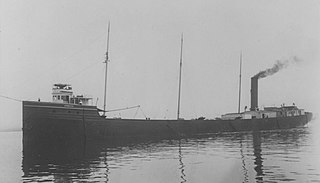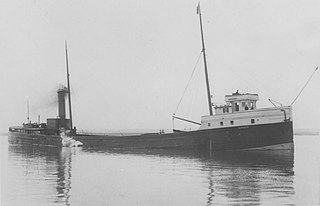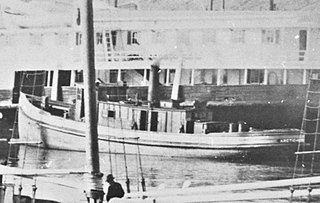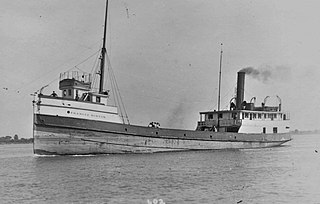
The PS Lady Elgin was a wooden-hulled sidewheel steamship that sank in Lake Michigan off the fledgling town of Port Clinton, Illinois, whose geography is now divided between Highland Park and Highwood, Illinois, after she was rammed in a gale by the schooner Augusta in the early hours of September 8, 1860. The passenger manifest was lost with the collision, but the sinking of Lady Elgin resulted in the loss of about 300 lives in what was called "one of the greatest marine horrors on record". Four years after the disaster, a new rule required sailing vessels to carry running lights. The Lady Elgin disaster remains the greatest loss of life on open water in the history of the Great Lakes.

SS Appomattox was a wooden-hulled, American Great Lakes freighter that ran aground on Lake Michigan, off Atwater Beach off the coast of Shorewood, Wisconsin in Milwaukee County, Wisconsin, United States in 1905. On January 20, 2005 the remnants of the Appomattox were listed on the National Register of Historic Places.

The SS Marquette was a wooden-hulled, American Great Lakes freighter built in 1881, that sank on Lake Superior, five miles east of Michigan Island, Ashland County, Wisconsin, Apostle Islands, United States on October 15, 1903. On the day of February 13, 2008 the remains of the Marquette were listed on the National Register of Historic Places.

SS Comet was a steamship that operated on the Great Lakes. Comet was built in 1857 as a wooden-hulled propeller-driven cargo vessel that was soon adapted to carry passengers. It suffered a series of maritime accidents prior to its final sinking in 1875 causing the loss of ten lives. It became known as the only treasure ship of Lake Superior because she carried 70 tons of Montana silver ore when it sank. The first attempts to salvage its cargo in 1876 and 1938 were unsuccessful. Comet was finally salvaged in the 1980s when the Great Lakes Shipwreck Historical Society illegally removed artifacts from the wreck. The artifacts are now the property of the State of Michigan and are on display as a loan to the Great Lakes Shipwreck Museum. The fate of her silver ore cargo is unknown. Comet's wreck is now protected by the Whitefish Point Underwater Preserve as part of an underwater museum.

SS Erie L. Hackley was a passenger and cargo ship that operated in Lake Michigan from 1882 to 1903. The ship sank in a storm near Green Island on 3 October 1903.

SS Choctaw was a steel-hulled American freighter in service between 1892 and 1915, on the Great Lakes of North America. She was a so-called monitor vessel, containing elements of traditional lake freighters and the whaleback ships designed by Alexander McDougall. Choctaw was built in 1892 by the Cleveland Shipbuilding Company in Cleveland, Ohio, and was originally owned by the Lake Superior Iron Company. She was sold to the Cleveland-Cliffs Iron Company in 1894 and spent the rest of her working life with it. On her regular route between Detroit, Escanaba, Marquette, and Cleveland, she carried iron ore downbound, and coal upbound.

SS Robert Wallace was a wooden-hulled American bulk freighter that served on the Great Lakes of North America from her construction in 1882 to her sinking in 1902 on Lake Superior near the town of Palmers, St. Louis County, Minnesota, United States. On November 17, 1902 shortly after leaving Superior, Wisconsin with a cargo of iron ore, Robert Wallace sprang a leak and sank. Her wreck was found in 2006, and on October 14, 2009, the wreck of Robert Wallace was listed in the National Register of Historic Places.

Australasia was a wooden-hulled American Great Lakes freighter that served on the Great Lakes of North America between her construction in 1884 to her burning and sinking in 1896. On October 18, 1896, while loaded with coal, the Australasia sank in Lake Michigan near the town of Sevastopol, Door County, Wisconsin, United States, after burning off Cana Island. On July 3, 2013, the wreck of the Australasia was added to the National Register of Historic Places.

The SS Lakeland was an early steel-hulled Great Lakes freighter that sank on December 3, 1924, into 205 feet (62 m) of water on Lake Michigan near Sturgeon Bay, Door County, Wisconsin, United States, after she sprang a leak. On July 7, 2015, the wreck of the Lakeland was added to the National Register of Historic Places.

SS Senator was a steel-hulled Great Lakes freighter that sank on Lake Michigan with the loss of nine lives and 268 Nash automobiles, on Halloween of 1929 after she was rammed in heavy fog by the bulk carrier Marquette. She lies in 450 feet (140 m) of water 16 miles northeast of Port Washington, Wisconsin. On April 12, 2016 her wreck was listed on the National Register of Historic Places.

The SS Atlanta was a wooden hulled Great Lakes steamer that sank in Lake Michigan off the coast of Cedar Grove, Wisconsin, United States, after a failed attempt of her being towed to shore ultimately killing 5 out of her 7 crew members on board. Her wreckage still remains at the bottom of the lake, and on November 6, 2017, the wreck of the Atlanta was listed on the National Register of Historic Places.

Arctic was a wooden-hulled tugboat that worked on the Great Lakes of North America from 1881 to 1930. In 1930 the Arctic was stripped of her machinery, and abandoned at Manitowoc, Wisconsin. On June 22, 2018, the remains of the Arctic were listed on the National Register of Historic Places.

SS Selah Chamberlain was a wooden-hulled Great Lakes freighter that sank in Lake Michigan in 1886, 6 miles (10 km) off the coast of Sheboygan, Sheboygan County, Wisconsin, United States after being rammed by the steamer John Pridgeon Jr. with the loss of five lives. On January 7, 2019, the wreck of Selah Chamberlain was listed on the National Register of Historic Places, and was given the reference number 100003288. She was the first shipwreck listed on the National Register of Historic Places in 2019.

The SS Francis Hinton was a wooden-hulled steam barge that sank in a gale off the coast of Manitowoc, Wisconsin, on Lake Michigan in 1909 while heavily laden with a cargo of lumber. On December 16, 1996, the wreck of the Francis Hinton was listed on the National Register of Historic Places.

Thomas Friant was a wooden-hulled ferry that served on the Great Lakes from her construction in 1884 to her sinking in 1924. In January 1924, while gillnetting out of Two Harbors, Minnesota in Lake Superior, she was holed by ice, and sank with no fatalities. In 2004 her wreck was discovered in over 300 feet (91 m) of water in pristine condition. The wreck of Thomas Friant was listed on the National Register of Historic Places in 2019.
City of Muskegon was an American steel-hulled sidewheel package and passenger steamer, built in 1881 for service on the Great Lakes, which was wrecked early on 28 October 1919 when it struck a pier at Muskegon, Michigan, at 0430 hrs., in a 60 miles per hour (97 km/h) gale, sinking in a period estimated between four and ten minutes. Nine crew and six passengers were killed. There are conflicting sources on the number on board, however. One account listed 37 passengers and a crew of 35.

SS Pere Marquette 18 was a steel-hulled Great Lakes train ferry that served on Lake Michigan from her construction in 1902 to her sinking in 1910.

SS S.R. Kirby was a composite-hulled bulk carrier that served on the Great Lakes of North America from her construction in 1890 to her sinking in 1916. On May 8, 1916, while heading across Lake Superior with a cargo of iron ore and the steel barge George E. Hartnell in tow, she ran into a storm and sank with the loss of all but two of her 22-man crew off Eagle Harbor, Michigan. For over 102 years the location of S.R. Kirby's wreck remained unknown, until June 2018, when her wreck was discovered by the Great Lakes Shipwreck Historical Society (GLSHS) in 825 feet (251 m) of water, completely broken up.

SS Vernon was a wooden-hulled American passenger and package freighter that sank in a Lake Michigan storm on October 29, 1887, near Two Rivers, Wisconsin, with the loss of between 36 and 50 lives, making her one of the deadliest shipwrecks ever to have occurred in Wisconsin. Only one of the people on board survived.

SS Merchant was an American iron–hulled passenger and package freighter in service between 1862 and 1875. The first iron–hulled merchant ship built on the Great Lakes, she was built in 1862 in Buffalo, New York, by the David Bell shipyard, out of components manufactured in Black Rock, New York, and Philadelphia, Pennsylvania. She was built for James C. and Edwin T. Evans of Buffalo, under whom she carried passengers and freight. Merchant made her maiden voyage in August 1862, sailing from Buffalo to Chicago. Between late 1872 and early 1873, she was lengthened by 30 feet (9.1 m), and had her passenger cabins removed. Also in 1873, Merchant was sold to the Erie & Western Transportation Company of Erie, Pennsylvania.




















